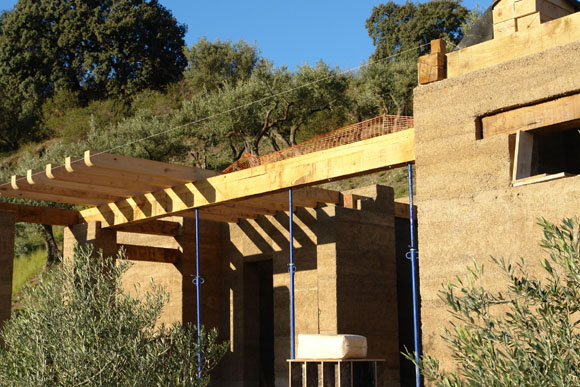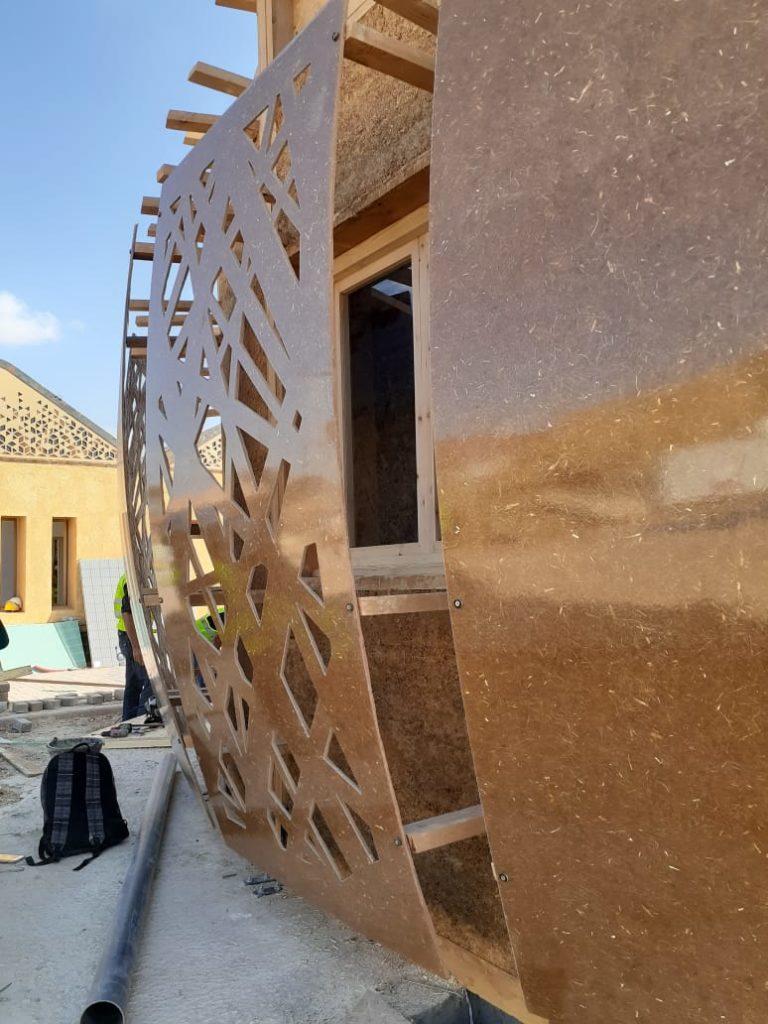If Monika Brümmer had been admitted to the department of fashion design at the renowned Universität der Künste (University of Fine Arts) in Berlin, we would probably all be wearing fashionably-designed and sustainably-made garments born of her imagination. Lacking a dedicated fashion design department at the time, the admissions committee reviewed her skillful drawings of garments or second skins, and saw her potential as a designer of shelters or outermost “third skins.” A brilliant fashion portfolio foretold Brümmer’s genius-to-come as an architect.
Brümmer, who was born in Braunschweig and went on to live in various cities around Germany, such as Neu Ulm, Hamburg, Heidelberg, and Berlin, has now spent the better part of three decades sustainably dressing landscapes and cities, building and sometimes rebuilding, creating not only structures but the materials used to build these structures. Her most revolutionary invention, currently in use in various places around the world, is the sustainable and durable material called Cannabric.

As the name implies, these bricks are fashioned out of the hemp plant, together with other ingredients that collaborate to make the product one that limits the use of non-renewable resources and draws from the earth to return ecological buildings to that same earth. How did an artist and designer such as Brümmer even think to tailor her approach to our current and urgent need for eco-friendly materials? I wondered, as I browsed photos of some of her most current projects.
According to Brümmer, her degree program placed a substantial emphasis on innovation. “The more unconventional our ideas [were], the better. We continuously had to invent new things,” she says, clarifying that the ideas “naturally had to be good for a specific case and make sense.” In 1996, Brümmer completed her final thesis project, one in which she melded the two main tenets of her university career — innovation and pragmatism. “Hemp building started in the 1990s in France but was unknown at that time in Germany. My professors found it brilliant. We didn’t get any lessons in sustainability at that time and I think I was not completely aware yet about the importance this project would gain. I simply had a vision.”
Brümmer’s vision would be her guiding force throughout the nearly 30-year career that would ensue. After presenting her successful graduate thesis, she continued to investigate the possible applications of hemp. After graduating from university and moving south, Brümmer combined her collegiate discoveries about the sustainability of hemp as a crop, together with the need for proper insulation in the drier climates she was now inhabiting.
“At that time hemp bricks didn`t exist,” says Brümmer. “In addition, the fact that I couldn’t find the right materials to build bioclimatic housing in the Mediterranean and other semiarid regions (where I moved to after Berlin), inspired me to create something new.” Necessity coupled with the success of the prior applications she had found for hemp, birthed what is now known as Cannabric.
More than just sustainable, Cannabric’s production leaves behind no trace, resulting in a negative carbon footprint. Utilizing the readily available, easy and quick to grow hemp plant as one of its main ingredients, it’s not only eco-friendly throughout its path to production; it also excels in its performance as a properly insulating and acoustically beneficial material. Moreover, the slim proportion of the material encourages structures that will themselves require low amounts of energy to properly heat, light, and maintain.

Another way to say this is that a builder who uses Cannabric for her constructions will not be giving up any of the functionality that synthetic, denatured, and sometimes toxic materials provide. It is a strong as reinforced concrete and as effective in keeping the low- or no-energy profile that is so coveted now just as well or better than a chemical varnish. Almost poetically green, Cannabric comes from the earth and the structures built from it seamlessly blend right back into the landscape, making the material ideal for restoration projects and brand-new builds alike.
Last year, my oldest son was assigned a semester-long research project about a great North American figure. A dabbler in both Lego-building and invention, he chose to write his presentation about Frank Lloyd Wright, the modernist architect from Wisconsin. He instinctively agreed with Wright’s decision that ornate Victorian buildings were not much more than “ugly, cluttered boxes,” and he became so absorbed by the simplicity of Wright’s designs and the way in which even larger structures melded with the nature around them, that his dad and I took him to Oak Park, Illinois over spring break to see some of them in person.
Corresponding with Brümmer about the birth of Cannabric, I am reminded of the way in which Wright’s wooden structures fit right into the forests that sit behind them; of the way he used glass to let the outside in; of the mimicry of nature’s shapes in his hexagonal parlors; of the effort to preserve the look, feel, and integrity of nature even as we make parts of it into our homes.
I had to ask Brümmer what it was that inspired her to work with a plant fiber, combining it with other materials, to make something renewable even before the need for it became as widely understood as it is today. Her response brought us back, all the way back to some of humankind’s first dwellings, used centuries before Wright, Brümmer, and me. Giving me an example of what inspired her, she mentions “the cave town of Guadix where my hemp brick factory is located. By making and restoring cave housings you [both] gain materials and conserve the landscape.”
What type of materials do you gain from the caves in southern Spain, I ask, realizing that her choice to place her factory in this region is more than purely coincidental. Besides wishing to restore these cave dwellings for historical reasons, Brümmer is able to source a special type of clay found there, which when mixed with hemp, yields her now-famous Cannabric. “These clays are considered waste [products], but I use them for Cannabric production,” she says, making clear her commitment to green building and zero-waste solutions.
To a lay person like myself, the combination of a plant and some clay sounds like a dicey proposition for durable, stable construction. I ask Brümmer to speak on the strength of the material and can practically see her shaking her head at my notion. “Cannabric is the only load-bearing hemp brick worldwide. In North Europe, very light and porous hemp building formulations with low thermal conductivities face harsh winter conditions, so they depend on a wooden support structure. In Mediterranean and semiarid climates we have wood shortages and at the same time very different thermal requirements. This climate is ideal for monolayer phase shifting materials like Cannabric that store solar energy and regulate temperature. The formulations I use reach densities apt for load-bearing walls (without lowering the hemp content), renouncing the need for a support structure.”
Like Wright in North America, Brümmer’s buildings are born of the landscape and fit in with the landscape. Her materials are sustainable, affordable, and practical, making them ideal for addressing shortages, not only in the availability of better materials but in housing itself. For the German architect and inventor, building herself a home base in Granada, Spain was no accident. The process of studying for a PhD in architecture from La Universidad de Granada keeps Brümmer in the perfect location to turn her attention toward building with Cannabric in exactly the kind of climate it’s designed to address. She challenged herself to build the very first hemp house in Spain, which gave her novel material national and international recognition.
Her most recent challenge, begun around 2014, was to take the technique and apply it to Morocco’s mountainous Rif region, to benefit the Berber people who live there. Central Rif dwellers harvest hemp to produce hashish, leaving behind the THC context of the plant together with what are considered to be the waste products of the synthesis process. Applying her talent for using what many others would simply throw away, Brümmer found that the residual parts of the plant are sufficient to produce a Moroccan version of Cannabric.
Her research and expertise has led her to become the main material developer for Adrar Nouh, a cooperative she co-founded together with Moroccan partners in the region. Their main interest is in using hemp building to conserve the culture and environment in this rough terrain. Brümmer stands out as a leader among mostly male veterans of the industry. Understandably, this project is one of her proudest accomplishments, but also one of the most difficult.
Partnering with two Moroccan high schools (the National School of Architecture of Tetouan and the National School of Applied Sciences of Tetouan) and the German Fraunhofer Center for Silizium Fotovoltaics, the cooperative built a 90 square meter prototype home out of local hemp and the necessary additives blended by Brümmer. Creating this particular blend, Brümmer essentially developed a unique formulation that is made of components endemic to the region, destined for use in the same.
Aside from the sustainability and local origin of the materials used in SUNIMPLANT, the Adrar Nouh cooperative seeks to make their buildings energy efficient. This led the German-Moroccan cooperative to enter the International Solar Decathlon competition in 2019. Brümmer explains the process: “We planned and constructed a one family hemp house that exclusively depends on solar energy. The building envelope consists of tamped hemp concretes with local transformed North African hemp and an outer building skin from high tech materials (hemp fiber composite with plant-based resins) that even in Europe only exist on an experimental level.”

Not only was the project a difficult summit to reach but it was perhaps misunderstood and undervalued. Brümmer reflects on its reception in the competition. She admits, “Doing a hemp building like this in Africa, under time constraints and conditions such as 42 degrees Celsius in the shade, with a less-experienced team of architectural students, was very hard. I think our ‘alien space ship’ SUNIMPLANT arrived 30 years too early to Africa. The jury didn’t realize how important the project is in terms of innovation, bioclimatic architecture, energy efficiency and indoor ambient quality. But we agree with other experts that it is unique and groundbreaking for the sustainable development of rural Africa.” The future applications of this type of building are hopeful and promising.
Proximity may have led Brümmer to Africa, where her research and development might not be appreciated yet, but serendipity has led her to a pathway into another market in dire need of sustainable and eco-friendly housing. Settling in Spain gives Brümmer linguistic access to Latin America, where innovators and architects like her are working to solve housing crises, while preserving ecological standards, in progressive markets like Chile, Costa Rica, Argentina, Uruguay, and Colombia. A quick peek at the roster of the 2018 Congreso de casas saludables reveals Brümmer as the only German in a group of Latin Americans and one of very few women in a world seemingly dominated by men.
Seeing what an exception to the rule she is leads me to tentatively ask Brümmer something I hope she will say no to. I am not disappointed when I question whether all of the obstacles in her path make her want to give up on this project and switch gears. Again, I can picture her shaking her head even while she admits that “selling ecologic building materials or building with them is difficult because there is still a general lack of know-how about green building materials and technologies amongst architects and builders. In addition, technologies of vernacular architecture done with local materials are undervalued, deprecated, or forgotten. Conversations with architects, builders and investors are therefore time-intensive and not always successful because those three parties together must agree on the final concept.”
For some reason, I immediately picture her as a lone woman in a room full of men and wonder if that is part of the current disconnect between her brilliant theory and the industry’s hesitation to put it into practice. As if reading my mind, she volunteers, “It is evident that plant-based building materials are more attractive to female architects, although there are also several male architects who have completed more than one building.”
Lone woman or not, Brümmer is not one to back away from a great idea. “I won’t give up on hemp because I continue discovering new things about it even after 25 years. Research is one of my new passions; I got involved with it in the past decade. The connection between research and practice is what I find essential, and in the last decade I realized that plant-based building materials are becoming the most promising sustainable building materials: They are renewable, insulating, carbon-storing, lightweight and have low embodied energy. Hemp is one of the fastest-growing crop with superior mechanical, weather and parasite resistance as compared to other crops,” she summarizes.
As with the work of most visionaries, it often takes the world a little time to catch up to the potential of the idea and the benefits it can bring. Without a doubt, and as we are forced to stand by and watch some of the lushest parts of our earth burn away to ash, making bricks out of plants and plant-based residue from regular agricultural processes is an exciting and logical direction for rural areas in Africa, Asia, and throughout Latin America. As for the U.S., bringing hemp-based building material to the market right now is a long-shot, as bureaucracy and confusion over the legality of hemp, as well as its stigma as a crop, has limited its practical viability as a crop let alone as a component of green architecture.
Latin America seems to be catching on to the potential of Cannabric perhaps a bit faster than other regions, but hopefully, as the Greta Thunbergs of the world continue to shine a light on the desperate need to quickly address environmental decay, this awakening will spread. In the meantime, Brümmer will be experimenting and building in her factory in Granada, making great headway into the necessary field of low-energy, high-sustainability housing.
For Image credit or remove please email for immediate removal - info@belatina.com






































